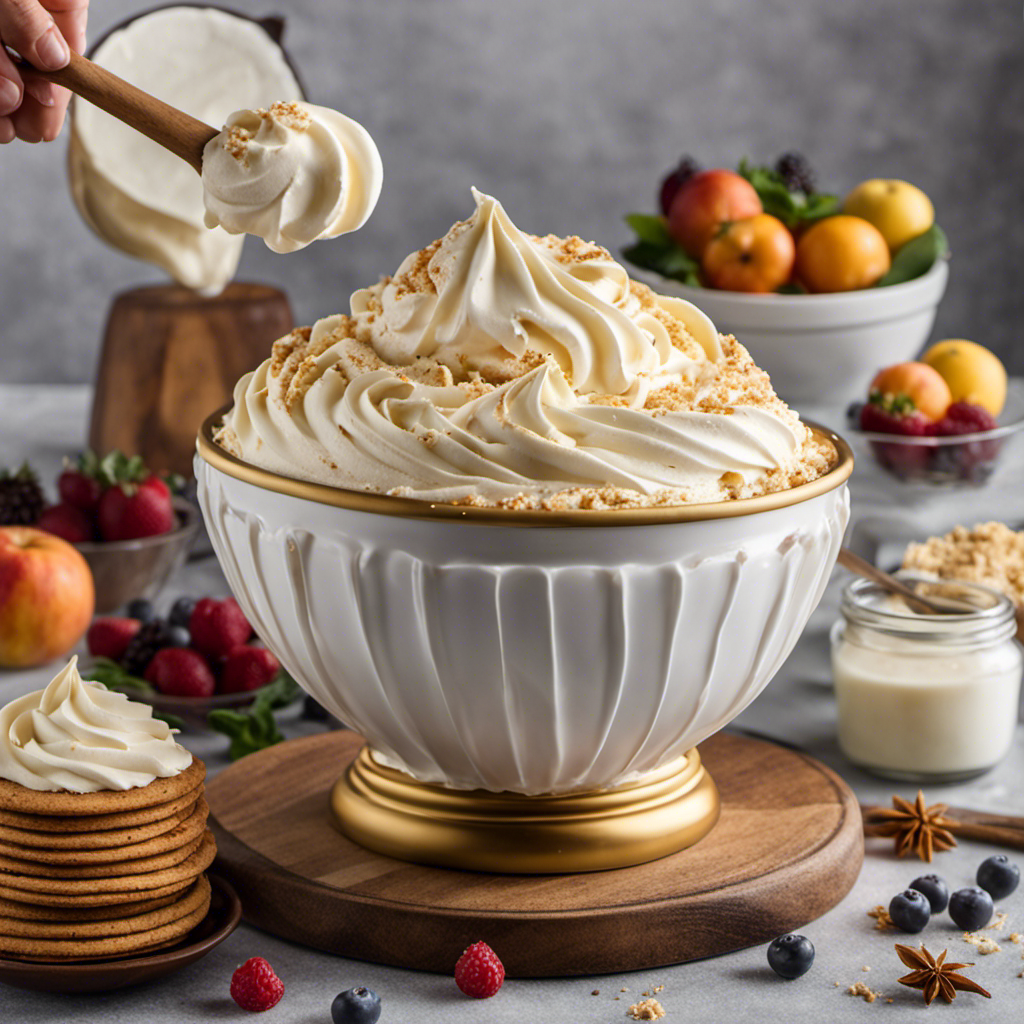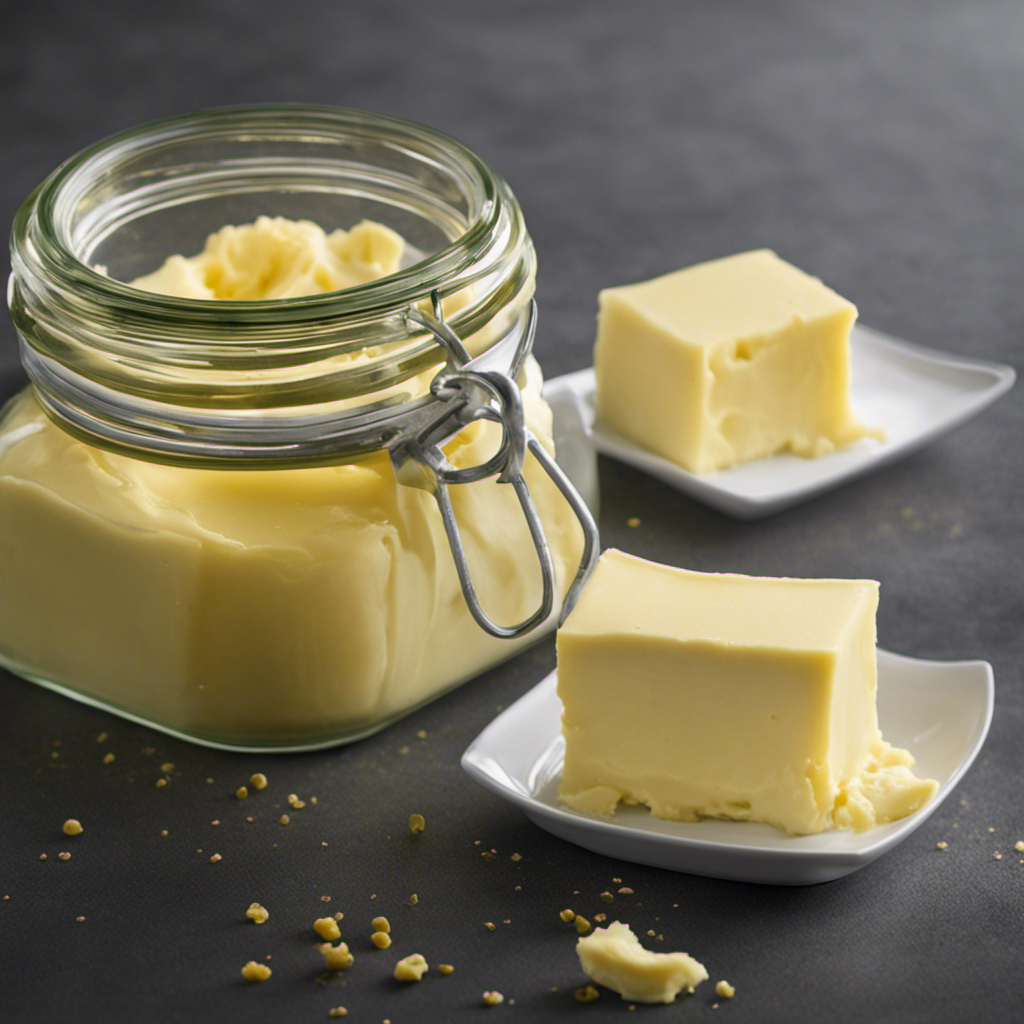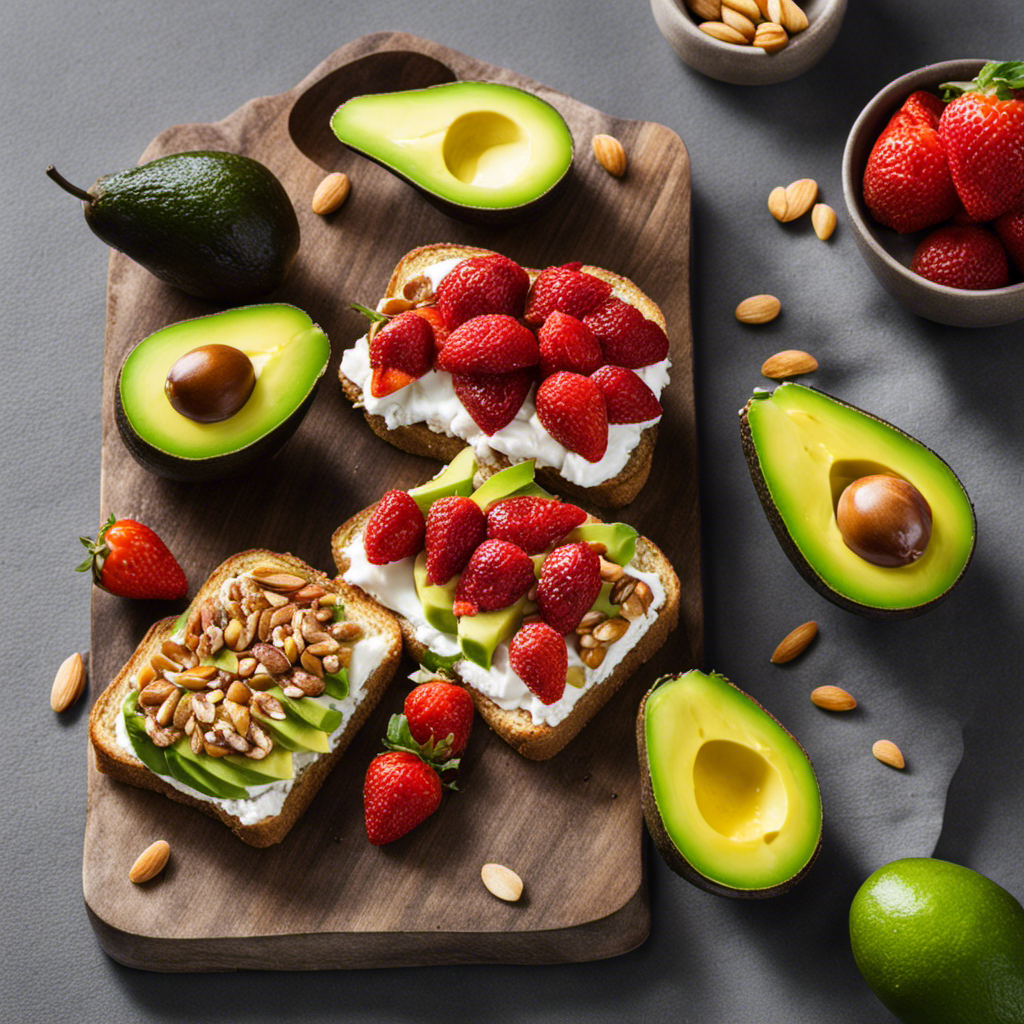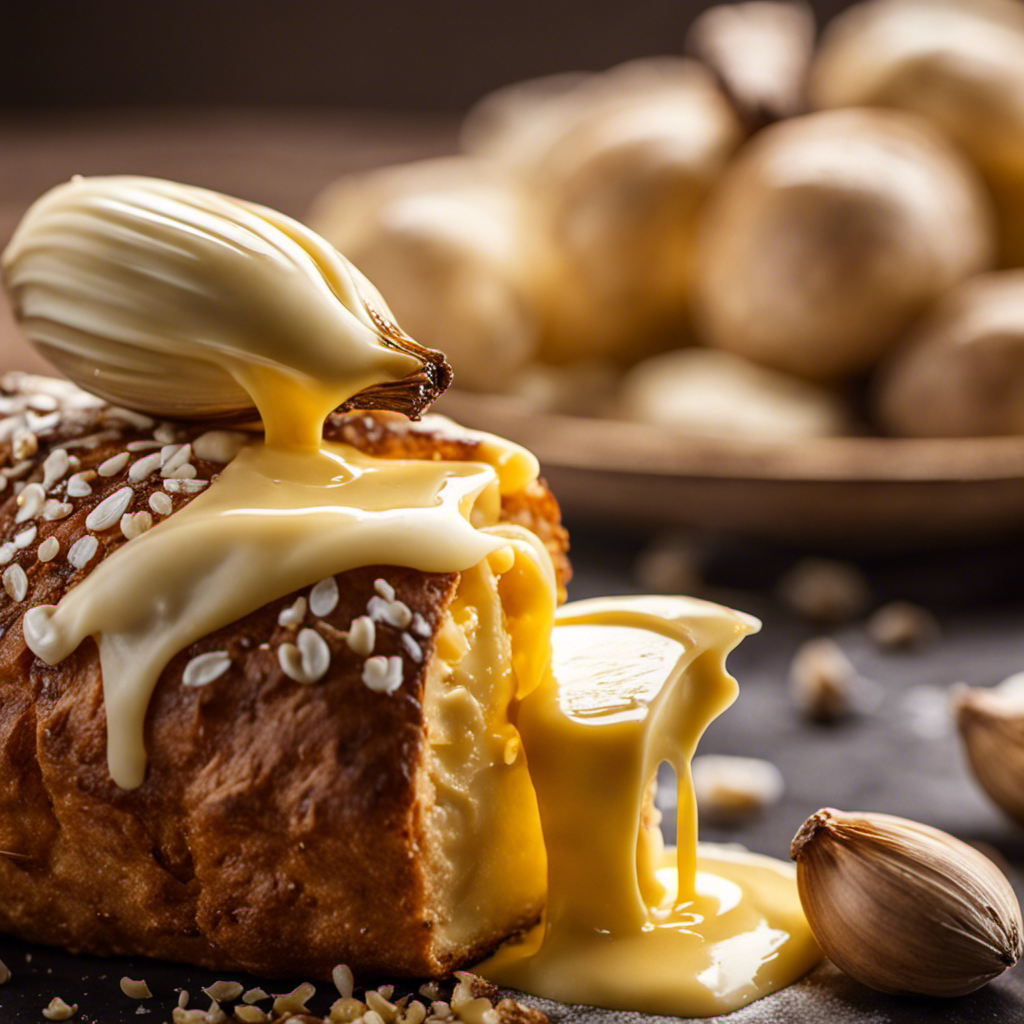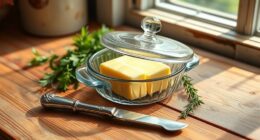Are you looking to elevate your cornbread? Check out this tutorial on making honey butter to take it up a notch.
This golden, creamy concoction will have your taste buds doing a happy dance. With just a few simple steps, you can create a velvety spread that perfectly complements the savory goodness of cornbread.
So grab your ingredients, melt that butter, and let’s dive into the sweet world of honey butter.
Key Takeaways
- Choose the sweetener based on personal preference and desired taste profile
- Melt the butter using either the microwave or stovetop method, ensuring it is fully melted and smooth
- Incorporate the sweetener to add sweetness and richness, and consider using alternative sweeteners for a unique twist
- Experiment with flavor enhancements like salt, seasonings, and herbs to elevate the taste of the honey butter and cornbread
Choosing the Right Ingredients
To make the best honey butter for your cornbread, you’ll need to choose the right ingredients. The first step is selecting the perfect sweetener. While honey is the traditional choice, you can also experiment with alternatives like maple syrup or agave nectar for a unique twist. These sweeteners add a touch of sweetness and enhance the flavor of your butter.
When choosing the right sweetener, consider the taste profile you want to achieve. Honey provides a rich, floral flavor, while maple syrup offers a deep, caramel-like taste. Agave nectar, on the other hand, has a milder, honey-like flavor. Each option brings its own unique character to the butter, so it’s all about personal preference.
Ultimately, the choice of sweetener is up to you. Whether you stick with traditional honey or venture into the world of alternative sweeteners, the result will be a delicious and flavorful honey butter that will elevate your cornbread to new heights.
Melting the Butter
Start by melting the butter in the microwave or on the stovetop. Melting the butter is an essential step in making honey butter for cornbread. While butter is the traditional choice for this recipe, there are also alternative options available. You can use margarine or even coconut oil as substitutes. Each alternative will impart a slightly different flavor to the honey butter, so feel free to experiment and find your favorite. When it comes to melting the butter, there are different methods you can choose from. Using the microwave is quick and convenient, but be sure to use a microwave-safe bowl and heat the butter in short intervals, stirring in between, to prevent it from splattering. Alternatively, you can melt the butter on the stovetop by using a small saucepan over low heat. This method allows for more control over the melting process and ensures the butter doesn’t burn. Whichever method you choose, make sure the butter is fully melted and smooth before continuing with the recipe.
| Butter Alternatives | Pros | Cons |
|---|---|---|
| Margarine | Lower in saturated fat, dairy-free option | May have a different flavor |
| Coconut oil | Adds a hint of tropical flavor | May overpower the taste of the honey |
When melting the butter, it’s important to consider the melting method that suits your needs. Whether you use the microwave or stovetop, both methods are effective in achieving a smooth and liquid consistency. The microwave method is quick and convenient, while the stovetop method allows for more control. Choose the method that works best for you and your kitchen setup.
Incorporating the Honey
Once the butter has melted, it’s time to mix in the honey and create a sweet and flavorful addition to your dish. Incorporating different flavors into your recipes can take them to a whole new level.
Honey butter is a delicious spread that adds a touch of sweetness and richness to cornbread and other baked goods. By using alternative sweeteners like honey instead of regular sugar, you can enhance the taste and add a unique twist to your dishes.
Here are some reasons why incorporating different flavors and alternative sweeteners can elevate your cooking:
- Adds complexity and depth to the dish
- Provides a natural and healthier sweetening option
- Enhances the overall flavor profile
- Creates a balance between sweet and savory
- Allows for experimentation and creativity in the kitchen
Now that you’ve mixed in the honey, it’s time to take your honey butter to the next level by adding a pinch of salt.
Adding a Pinch of Salt
When it comes to cooking, salt is often the unsung hero, enhancing the flavors of your dishes in ways you may not even realize.
Not only does it bring out the natural flavors of ingredients, but it also helps to strike the perfect balance between saltiness and sweetness.
Don’t be afraid to experiment with the saltiness of your dishes, as it can make all the difference in creating a truly delicious and well-rounded meal.
Salt Enhances Flavor
To enhance the flavor of your honey butter for cornbread, you’ll need to add a pinch of salt. Salt plays a crucial role in baking by enhancing the taste of the ingredients. But did you know that salt also has health benefits?
Here are some reasons why salt is beneficial for your body:
- Regulates fluid balance in the body
- Helps with nerve and muscle function
- Aids in digestion
- Supports proper hydration
- Enhances the taste of food
Perfect Salt-To-Sweet Balance
Finding the perfect balance of salt and sweetness in your recipe is key to creating a delicious and well-rounded flavor. When it comes to experimenting with different sweeteners, you have a variety of options to choose from.
Honey, maple syrup, and agave nectar are all popular choices that can add a touch of sweetness to your dish. However, it’s important to remember that these sweeteners can vary in intensity, so start with a small amount and taste as you go.
In addition to sweeteners, spices can also play a vital role in balancing flavors. Cinnamon, nutmeg, and cardamom can add warmth and depth to your recipe, while a pinch of salt can enhance the overall taste.
Don’t be afraid to get creative and find the perfect combination of sweet and savory flavors that suits your palate.
Experiment With Saltiness
Now that you’ve mastered the art of achieving the perfect salt-to-sweet balance in your honey butter for cornbread, it’s time to take your butter game to the next level.
Let’s explore the world of experimenting with other seasonings and exploring different butter flavors. Here are some exciting ideas to get you started:
- Mix in some garlic powder for a savory twist.
- Try adding a pinch of cayenne pepper for a subtle kick.
- Sprinkle in some dried herbs like thyme or rosemary for an aromatic touch.
- For a hint of smokiness, add a dash of smoked paprika.
- Get adventurous and incorporate different types of butter, such as salted, unsalted, or even flavored butters like garlic or herb-infused varieties.
By playing around with various seasonings and butter flavors, you can create a honey butter that perfectly complements your cornbread and tantalizes your taste buds.
Whisking for a Smooth Consistency
Once you’ve gathered your ingredients, start whisking them together until the honey and butter blend into a smooth consistency. Whisking is a fundamental technique in achieving the desired texture for your honey butter.
Hold the whisk firmly and move it in a circular motion, making sure to incorporate air into the mixture. As you whisk, you’ll notice the honey and butter begin to combine, transforming from separate entities into a luscious, velvety spread.
The key is to keep whisking until there are no visible clumps or streaks. Be patient and persistent, as this process may take a few minutes.
The result will be a glossy, smooth honey butter that is perfect for slathering onto warm, freshly baked cornbread. Enjoy the delightful combination of sweetness and richness in every bite.
Storing and Serving Tips
When it comes to storing and serving your honey butter, there are a few key points to keep in mind.
First, it’s important to know the proper storage techniques to ensure the butter stays fresh and delicious.
Second, presentation and garnish play a crucial role in enhancing the overall dining experience.
And finally, understanding the temperature recommendations will help you serve the honey butter at its best.
Proper Storage Techniques
To keep your honey butter fresh for longer, store it in an airtight container in the refrigerator. Proper storage techniques are essential to prevent spoilage and maintain the delicious taste of your homemade honey butter. Here are some tips to help you store it correctly:
-
Use an airtight container: This will keep air out and prevent the butter from absorbing any odors from the refrigerator.
-
Refrigerate promptly: After making the honey butter, transfer it to the refrigerator as soon as possible to keep it at a safe temperature.
-
Keep it away from strong odors: Honey butter can easily absorb strong odors, so store it away from pungent foods like onions or garlic.
-
Label and date: To keep track of its freshness, label the container with the date of preparation. Honey butter can typically be stored for up to two weeks.
-
Avoid temperature fluctuations: Fluctuating temperatures can cause condensation and promote spoilage, so try to keep the refrigerator temperature consistent.
Presentation and Garnish
Now that you know how to properly store your homemade honey butter, let’s talk about presentation and garnish techniques to make your cornbread even more enticing. The way you present your dish can greatly impact the overall dining experience. Consider using creative presentation ideas to make your cornbread stand out on the table.
One popular garnish technique is to sprinkle some fresh herbs, such as parsley or chives, on top of the cornbread. This not only adds a pop of color but also enhances the flavor. Another idea is to drizzle some melted honey butter over the cornbread just before serving. This adds a glossy sheen and a decadent touch to the dish.
To help you visualize these ideas, here’s a table showcasing different garnish techniques and creative presentation ideas for your cornbread:
| Garnish Techniques | Presentation Ideas |
|---|---|
| Fresh herbs (parsley, chives) | Drizzle of melted honey butter |
| Edible flowers (nasturtiums, pansies) | Serving on a wooden cutting board |
| Toasted nuts (walnuts, pecans) | Served in individual cast-iron skillets |
| Honeycomb | Sprinkling of powdered sugar |
Temperature Recommendations
One way to ensure the perfect cornbread is by keeping an eye on the oven temperature. Temperature control is essential for achieving a moist and evenly baked cornbread. Here are some tips to help you maintain the ideal oven temperature for your cornbread:
- Preheat the oven to 425°F (218°C) before placing the cornbread batter in.
- Use an oven thermometer to ensure the accuracy of the temperature.
- Avoid opening the oven door frequently as it can cause temperature fluctuations.
- If your oven tends to run hot, consider lowering the temperature slightly to prevent the cornbread from drying out.
- If your oven runs cooler, you may need to increase the temperature slightly to ensure proper baking.
In addition to controlling the oven temperature, the honey measurement you use in your cornbread can also impact the final result. Too much honey can make the cornbread overly sweet and moist, while too little may result in a drier texture. Finding the right balance is key to achieving a delicious cornbread with a hint of sweetness.
Now let’s explore some variations and flavor enhancements you can try to elevate your cornbread even further.
Variations and Flavor Enhancements
If you want to take your honey butter to the next level, try adding a pinch of cinnamon for a warm and cozy flavor. The sweet and spicy notes of cinnamon blend perfectly with the rich and creamy taste of honey butter. This simple addition can elevate your cornbread experience to new heights.
But why stop there? There are countless flavor combinations and creative additions you can experiment with to make your honey butter even more exciting. For a refreshing twist, try adding a hint of citrus zest, like lemon or orange. Or if you want a savory kick, sprinkle in some finely chopped herbs, like rosemary or thyme.
The possibilities are endless, so don’t be afraid to get creative and explore different flavor profiles. Your taste buds will thank you.
Conclusion
So there you have it, the perfect recipe for honey butter to complement your cornbread. With just a few simple steps, you can create a smooth and flavorful spread that will take your cornbread to a whole new level.
It’s ironic how something as simple as honey and butter can make such a difference in taste. So go ahead, give it a try and see for yourself the magic of honey butter.
Your taste buds will thank you!

